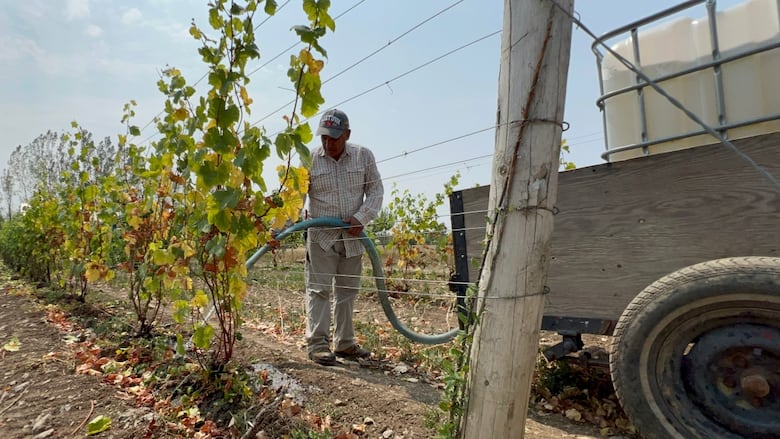Winemaker hand-watering vines as Prince Edward County bakes
About 80% less rain than normal in June, July

Staring down the driest summer in his 15 years owning a vineyard, Tim Kuepfer has resorted to something he describes as "nearly impossible" — hand-watering each one of his roughly 12,000 plants.
While a field crew slowly moves from vine to vine, he's been driving back and forth between Broken Stone Winery and Wellington in eastern Ontario's Prince Edward County, filling and hauling a pair of 1,000-litre water totes to try and keep up.
"Honestly, I'm doubting my own sanity considering it, but I don't know what the option is," Kuepfer said. "I have to make sure that I do everything I can to prevent loss of the crop. It's just the way it is."
He estimates he'll make the 20-kilometre round trip 60 times over the course of a week to gather enough water for the whole vineyard. Then it will be time to start the process all over again — until it rains.
70-90% less rainfall than normal
The county, known for its wine making, has been sweltering under an unrelenting sun.
It stands out as having the largest rainfall deficit in southern Ontario since the beginning of the summer, according to Environment Canada spokesperson Alexandra Cournoyer.
Over the past two months the county has had 70 to 90 per cent less rain than would normally be expected and that trend is likely to continue, for at least the first two weeks of August, she added.
Agriculture and Agri-Food Canada classified conditions in the region as either "abnormally dry" or "moderate drought" as of the end of June.
Signs of the weather are everywhere: scorched lawns, stunted crops and leaves littering the ground like mid-October as trees try to conserve moisture.
For Kuepfer it's meant watching his plants yellow and some grapes shrivel on the vine.
"We are definitely going to experience 15 to 20 per cent loss in production because some of the plants, the weaker plants, have just given up and lost all their leaves," he explained.
At this point in the season he's already sunk thousands of dollars into pesticides, labour and fertilizer, but that's not the only impact.
Kuepfer said it takes an emotional toll too.
"This year seemed like it was going to be the perfect year," he said, describing how the crop flowered beautifully and there were plenty of grapes earlier on.
Broken Stone isn't alone. Kuepfer said grape leaves are yellowing across the county and some, especially those with shallow soil over bedrock, might not end up harvesting anything at all.
Others, with deeper ground or deeper pockets have been watering for weeks already and will likely make out OK, according to the winemaker.

Other crops struggling too
It's a similar story for all crops around the area.
Don Williams, a seventh-generation farmer and vice-president with the Ontario Federation of Agriculture, said it's been a "depressing" growing season.
It started in the spring with wet weather that bogged down planting. Now growers are confronting "extremely dry" conditions that threaten soybeans, while corn in some parts of the county is "looking terrible," he said.
"We don't control none of it," Williams said of the weather. "That's the thing with farming is you take what you get."
The farmer said you have to be optimistic in order to plant something and hope it grows, adding you just "gotta think that the rains are going to come."
Kuepfer said after years in the business he's developed somewhat of a stoic attitude to weather and is trying to look for positives too.
Smaller grapes mean a good juice-to-skin ratio and tend to make good quality wine, but he still needs to be able to make enough of it to profit.
Right now there's no rain in sight, and Kuepfer said quick calculation on the cost of watering shows it's around $1,000 a day.
Based on experience from past dry years, he's holding onto a hope all that work could result in some weather-related reverse psychology.
"Every time before, when I started watering the vineyard, it's always rained almost immediately."
